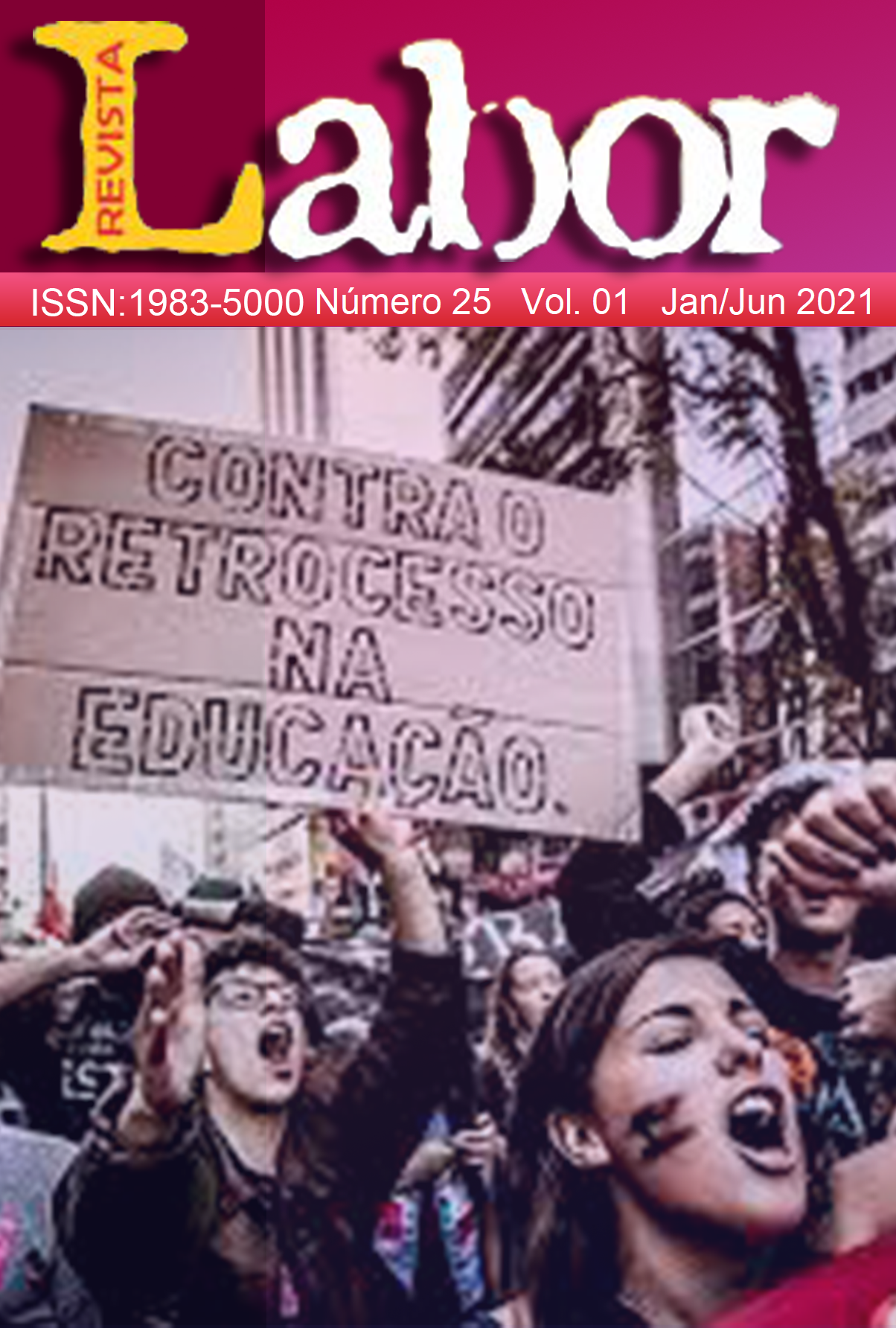An experience of insertion of Programming Language in High School Integrated with Technical Professional Education based on curricular flexibility
DOI:
https://doi.org/10.29148/labor.v1i25.44110Keywords:
Diversidade curricular, Tecnologias educacionais., Python, Perfil profissionalAbstract
The principle of curricular flexibility presupposes innovations in pedagogical projects to meet the new realities, among which, we highlight the technological immersion of contemporary society. In this sense, we present a curricular menu as a theoretical-methodological contribution to the development of skills related to the learning of programming language (i.e. algorithmic thinking and real-world problem solving in computational language). The menu was consolidated through a holistic approach based on criteria such as coherence, feasibility and a learning curve that provide a global character due to the heterogeneity of training. Its principles are found in the connection between professional training and technological implementation. The feasibility of the proposal was suggested by scale acceptance forms and observations made in the context of the classroom in the IFNMG's integrated computer and environmental courses. The level of learning was rated on a scale of 1 = very easy to 5 = very difficult, with an average of 2.57. Our result suggests that in the adopted language, Python, no item was considered particularly difficult, which can be related to its compact and clean syntax, when compared to other languages. The preliminary application of the proposal in the IFNMG to different professional profiles showed good interaction of the students with Python, as well as, assimilation and the ability to reframe the acquired content through the construction of proposals for joint work and professional application.
References
AZEVEDO, Diego Napoleão Viana; DE VASCONCELLOS, Maria Lúcia Barbosa. Formação de tradutores: a Contribuição da terminologia para uma proposta de desenho de ementa de disciplina a partir de abordagem por tarefa de tradução. Traduzires, v. 2, n. 2, p. 41-52, 2013.
BRASIL. Lei de Diretrizes e Bases da Educação Nacional de 20 de dezembro de 1996. MEC. Brasília: DF.
BRASIL. Resolução Nº 6, de 20 de setembro de 2012. Diário Oficial da União. Brasília: DF.
BRASIL. Lei nº 13.415, de 16 de fevereiro de 2017. Diário Oficial da União. Brasília: DF.
CONIF. FDE. Diretrizes indutoras para a oferta de cursos técnicos integrados ao Ensino Médio na Rede Federal de Educação Profissional, Científica e Tecnológica (2018). Disponível em: <https://www.ifsc.edu.br/documents/38101/1079513/Diretrizes+EMI+-+Reditec2018.pdf/0cd97af4-bad5-b347-4869-7293ac87eb69> Acesso em 04 de novembro de 2019.
DA SILVA, Claudia Sebastiana Rosa, & PORTILHO, Evelise Maria Labatut. Cultura Escolar, Formação Continuada E Estratégias De Ensino. Revista e-Curriculum, v.16, n.3,p. 911-933, 2018.
DA SILVA, Thiago Reis et al. Ensino-aprendizagem de programação: uma revisão sistemática da literatura. Revista Brasileira de Informática na Educação, v. 23, n. 1, 2015.
SCHOOLNET, Europian. Computing our future. computer programming and coding priorities, school curricula and initiatives across europe. Technical report European Schoolnet, 2014.
FAROOQ, Muhammad Shoaib et al. A Qualitative Framework for Introducing Programming Language at High School. Journal of Quality and Technology Management, v. 8, n. 2, 2012.
FREIRE, Paulo. Extensão ou Comunicação. 7ª ed. Rio de Janeiro, Paz e Terra,1969.
FERRETI, Celso João; SILVA, Monica Ribeiro da. Reforma do ensino médio no contexto da medida provisória n 746/2016: estado, currículo e disputas por hegemonia. Educação & Sociedade, v. 38, n. 139, p. 385-404, 2017.
GARDNER, Howard, CHEN, Jie-qi & MORAN, Seana.Inteligências múltiplas. Penso Editora, 2009.
GRANDELL, Linda et al. Why complicate things?: introducing programming in high school using Python. In: Proceedings of the 8th Australasian Conference on Computing Education-Volume 52. Australian Computer Society, Inc., p. 71-80,2006.
IFNMG, Instituto Federal de Educação, Ciência e Tecnologia do Norte de Minas Gerais (2017). Projeto pedagógico de curso. <Disponível em: http://documento.ifnmg.edu.br /action.php?kt_path_info=ktcore.actions.document.view&fDocumentId=22345> Acesso: 10/novembro/2018.
MILLMAN, K. Jarrod; AIVAZIS, Michael. Python for scientists and engineers. Computing in Science & Engineering, v. 13, n. 2, p. 9-12, 2011.
MITCHEL RESNICK, J. M. Scratch: Programming for Everyone. 2009.
PALFREY, John Gorham; GASSER, Urs. Born digital: Understanding the first generation of digital natives. ReadHowYouWant. com, 2011.
PERKEL, Jeffrey M. Programming: pick up Python. Nature News, v. 518, n. 7537, p. 125, 2015.
PINTO, A. C., BARROS, S., GARANHANI, M. L., FLORIANO, L. S. M., & SKUPIEN, S. V. Conceito de ser humano de professores do curso de enfermagem à luz do homo complexus de Edgar Morin/Human concept of teachers of nursing course in the light of edgar morin homo complexus. Brazilian Journal of Development, v.5, n.9, p.14543-14555, 2019.
SILVA, Mariane Carloto; DE OLIVEIRA PAVÃO, Silvia Maria. Possibilidades das adaptações curriculares na educação superior. Revista e-Curriculum, v. 16, n. 3, p. 621-649, 2018.
SCAICO, Pasqueline Dantas et al. Teaching Programming in High School: an approach guided by design with Scratch language. Brazilian Journal of Computers in Education, v. 21, n. 02, p. 92, 2013.
TABILE, Ariete Fröhlich; JACOMETO, Marisa Claudia Durante. Fatores influenciadores no processo de aprendizagem: um estudo de caso. Revista Psicopedagogia, v. 34, n. 103, p. 75-86, 2017.
VALENTE, José Armando. Integração do pensamento computacional no currículo da educação básica: diferentes estratégias usadas e questões de formação de professores e avaliação do aluno. Revista e-Curriculum, v. 14, n. 3, p. 864-897, 2016.
Downloads
Published
How to Cite
Issue
Section
License
Autores que publicam nesta revista concordam com os seguintes termos:
1. Autores mantém os direitos autorais e concedem à revista o direito de primeira publicação, com o trabalho simultaneamente licenciado sob a Licença Creative Commons Attribution que permite o compartilhamento do trabalho com reconhecimento da autoria e publicação inicial nesta revista.
2. Autores têm autorização para assumir contratos adicionais separadamente, para distribuição não-exclusiva da versão do trabalho publicada nesta revista (ex.: publicar em repositório institucional ou como capítulo de livro), com reconhecimento de autoria e publicação inicial nesta revista.
3. Autores têm permissão e são estimulados a publicar e distribuir seu trabalho online (ex.: em repositórios institucionais ou na sua página pessoal) durante o processo editorial informando que o artigo está em processo de publicação, já que isso pode aumentar o impacto e a citação do trabalho publicado (Veja O Efeito do Acesso Livre).


